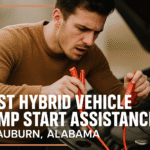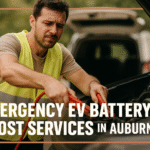Car batteries often die during the most inconvenient times such as late-night grocery runs, early morning commutes or even while you’re just parked outside a friend’s house. It’s actually easier than it seems to jump start a car which is good news. You can get back on the road quickly if you have the correct information and equipment. This guide explores how to jump start a car in easy steps with the proper and safe mea car. Following easy steps will have your engine humming again without much effort whether you’re restoring your own vehicle or helping a friend.
The Right Way to Jump Start a Car
Before the exploration of the actual steps, it’s essential to talk about safety. Jump starting a car involves electricity, so it’s crucial to take proper precautions to avoid injury or damage to the vehicles. All you’ll need is a set of jumper cables and a working vehicle with a fully charged battery. Now let’s break it down step by step.
Locate the Battery in Both Vehicles
Locate the batteries by opening the hood of both vehicles. The majority are located close to the engine bay’s front, but some might be hidden in a corner or even beneath a plastic cover. Verify the positive terminals (+) and negative (-). Typically, the negative is black and the positive is red, but don’t only look for color, also look for the symbols.
Position the Cars Safely and Correctly
Make sure the cars don’t touch, but park the working car close enough for the jumper cables to reach. Put both cars in park (or, if manual, in neutral), switch off the ignition, and apply the parking brakes. This ensures stability and safety while you’re working.
Connect the Jumper Cables in the Correct Order
Make sure the jumper cables are connected in the right order. This step is crucial: To securely connect the jumper cables, follow these steps:
- Connect the red clamp to the positive terminal (+) of the dead battery.
- Attach the red clamp to the positive terminal (+) of a functioning battery.
- Attach the black clamp to the negative terminal (-) of a functioning battery.
- Attach a black clamp to a metal part of the dead vehicle, such as an unpainted bolt on the engine block (not the battery itself).
This technique helps avoid potentially harmful sparks close to the battery.
Start the Working Vehicle First
Using the functional battery, start the vehicle and leave it running for a short while. This enables the dead battery to accumulate some charge before trying to start it.
Attempt to Start the Dead Vehicle
Disconnecting the cables is necessary once the dead car starts, but you must do it backward.
- The black clamp should be taken off the metal.
- From the functional battery, remove the black clamp.
- The working battery red clamp should be removed.
- From the dead battery, remove the red clamp.
During removal, avoid letting the clamps come into contact with one another or any metal surfaces.
Let the Engine Run After the Jump
Once the jump is over, let the engine run. Allow your car to run for at least 15 to 30 minutes after it starts. The battery is recharged as a result. Drive it if you can. Don’t shut off the engine too soon because you don’t want it to die again as soon as you park
If your battery dies suddenly, it’s wise to have it checked, but a jump start might fix the problem right away. Free battery tests are available at many auto parts stores. Consider replacing it if it’s older than three to five years to prevent surprises later.
Final Thoughts
It doesn’t have to be scary to jump-start a car. You are more than capable of handling a dead battery like an expert if you have a decent set of cables and the knowledge you just acquired. Just keep your composure, adhere to the proper protocol, and put safety first. It’s a minor triumph that saves time, money, and stress, so once you are back on the road, savor the lovely hum of a running engine. Contact us at Burnham Towing for consultation, professional inspection, and roadside assistance. The small effort you spend in advance will pay off during emergencies since you will know precisely how to handle the situation.
FAQs
When the battery of your car is dead and cannot hold a charge anymore, jump-starting may temporarily solve the problem but you may require a new battery in the near future. When jump-starting fails to work, you should have your battery checked or replaced.
In case your car fails to start even after jump-starting, ensure that the jumper cables are well connected and repeat the process. In case it fails to start, then the problem could be with the alternator, battery or the electrical system and you need to take it to a mechanic.
When properly performed, jump-starting is not supposed to harm the electrical system of your car. Nevertheless, improper cable connections (e.g. reversing the polarity) or incompatible power source may result in electrical damage. Never skip the right procedure and safety measures.





